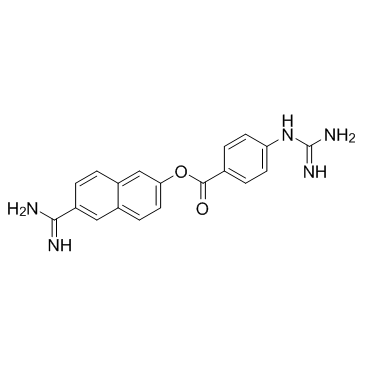Nafamostat
Modify Date: 2024-01-03 23:04:51

Nafamostat structure
|
Common Name | Nafamostat | ||
|---|---|---|---|---|
| CAS Number | 81525-10-2 | Molecular Weight | 347.371 | |
| Density | 1.4±0.1 g/cm3 | Boiling Point | 637.2±65.0 °C at 760 mmHg | |
| Molecular Formula | C19H17N5O2 | Melting Point | N/A | |
| MSDS | N/A | Flash Point | 339.1±34.3 °C | |
Use of NafamostatNafamostat is a broad spectrum serine protease inhibitor, kallikrein inhibitor, and inhibits blood coagulation; is also a possible complement inhibitor.Target: Serine ProteaseTranilast (FUT-175) is an antiallergic drug for bronchial asthma. It has been used for the treatment of allergic disorders such as asthma, allergic rhinitis and atopic dermatitis. It has also been investigated for use as an antiproliferative drug on drug-eluting stents.A 20-40 mg/h dose of FUT-175 prolonged coagulation time sufficiently in the instrumental blood of the extracorporeal circuit but not in the systemic blood. Its anticoagulant activity decreased immediately after hemodialysis. Therefore, we could manage all patients without any bleeding trouble during hemodialysis with FUT-175 as an anticoagulant. Although there were side effects of FUT-175, such as nausea, vomiting, itching and eruption, they were not serious, and FUT-175 could be administered without interruption. FUT-175 seems to be useful as an anticoagulant during hemodialysis for patients susceptible to bleeding. |
| Name | nafamostat mesylate |
|---|---|
| Synonym | More Synonyms |
| Description | Nafamostat is a broad spectrum serine protease inhibitor, kallikrein inhibitor, and inhibits blood coagulation; is also a possible complement inhibitor.Target: Serine ProteaseTranilast (FUT-175) is an antiallergic drug for bronchial asthma. It has been used for the treatment of allergic disorders such as asthma, allergic rhinitis and atopic dermatitis. It has also been investigated for use as an antiproliferative drug on drug-eluting stents.A 20-40 mg/h dose of FUT-175 prolonged coagulation time sufficiently in the instrumental blood of the extracorporeal circuit but not in the systemic blood. Its anticoagulant activity decreased immediately after hemodialysis. Therefore, we could manage all patients without any bleeding trouble during hemodialysis with FUT-175 as an anticoagulant. Although there were side effects of FUT-175, such as nausea, vomiting, itching and eruption, they were not serious, and FUT-175 could be administered without interruption. FUT-175 seems to be useful as an anticoagulant during hemodialysis for patients susceptible to bleeding. |
|---|---|
| Related Catalog | |
| References |
| Density | 1.4±0.1 g/cm3 |
|---|---|
| Boiling Point | 637.2±65.0 °C at 760 mmHg |
| Molecular Formula | C19H17N5O2 |
| Molecular Weight | 347.371 |
| Flash Point | 339.1±34.3 °C |
| Exact Mass | 347.138214 |
| PSA | 138.07000 |
| LogP | 1.93 |
| Vapour Pressure | 0.0±1.9 mmHg at 25°C |
| Index of Refraction | 1.694 |
| Storage condition | 2-8℃ |
| 6-Carbamimidoyl-2-naphthyl 4-carbamimidamidobenzoate |
| 6-carbamimidoylnaphthalen-2-yl 4-carbamimidamidobenzoate |
| Nafamostat Dimethanesulfonate |
| NAFAMOSTAT MESILATE |
| Benzoic acid, 4-[(aminoiminomethyl)amino]-, 6-(aminoiminomethyl)-2-naphthalenyl ester |
| 6-Amidino-2-naphthyl-4-guanidinobenzoate |
| Futhan |
| 6-AMIDINO-2-NAPHTHYL-4-GUANIDINOENZOATE,MESYLATE |
| Nafamstat |
| Nafamostat |
| 6-carbamimidoylnaphthalen2-yl 4-(diaminomethyleneamino) benzoate |
| FUT-175 |
| 6-Amidino-2-naphthyl 4-guanidinobenzoate |
| NafamostatMesilateBase |
| 4-[(Aminoiminomethyl)amino]benzoic Acid 6-(Aminoiminomethyl)-2-naphthalenyl Ester |
| 4-Guanidinobenzoic acid 6-amidino-2-naphtyl ester |